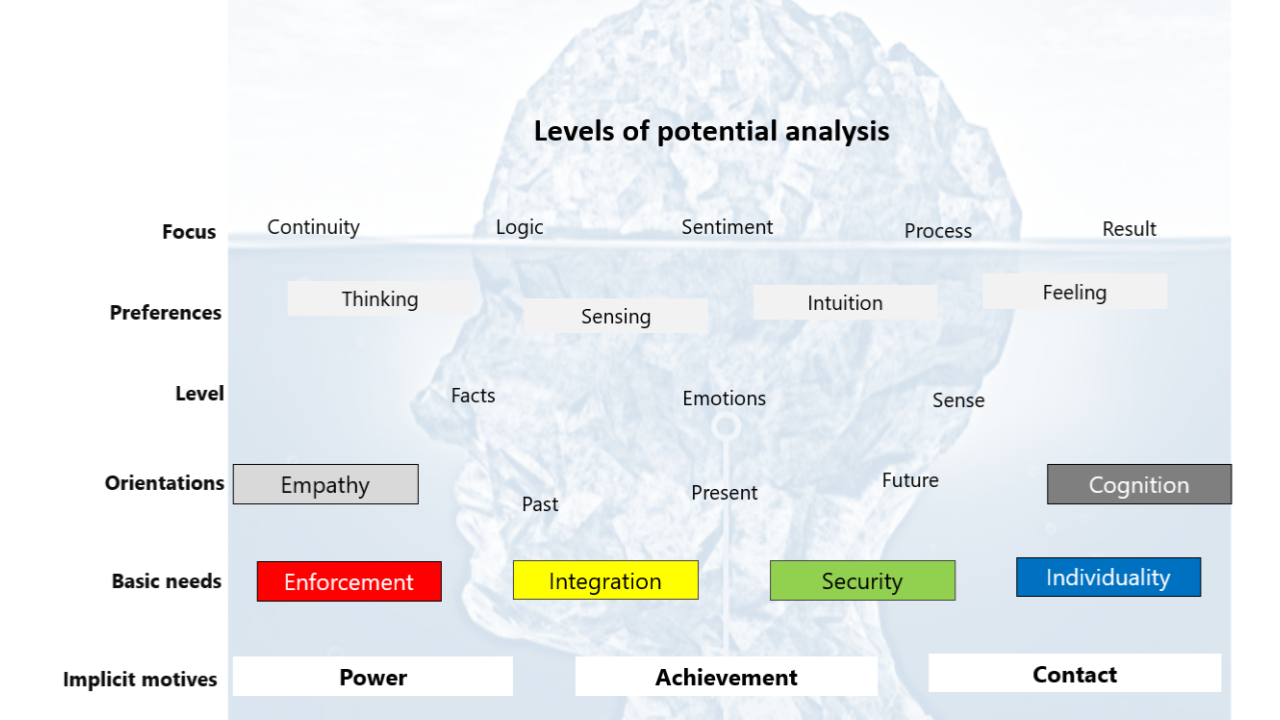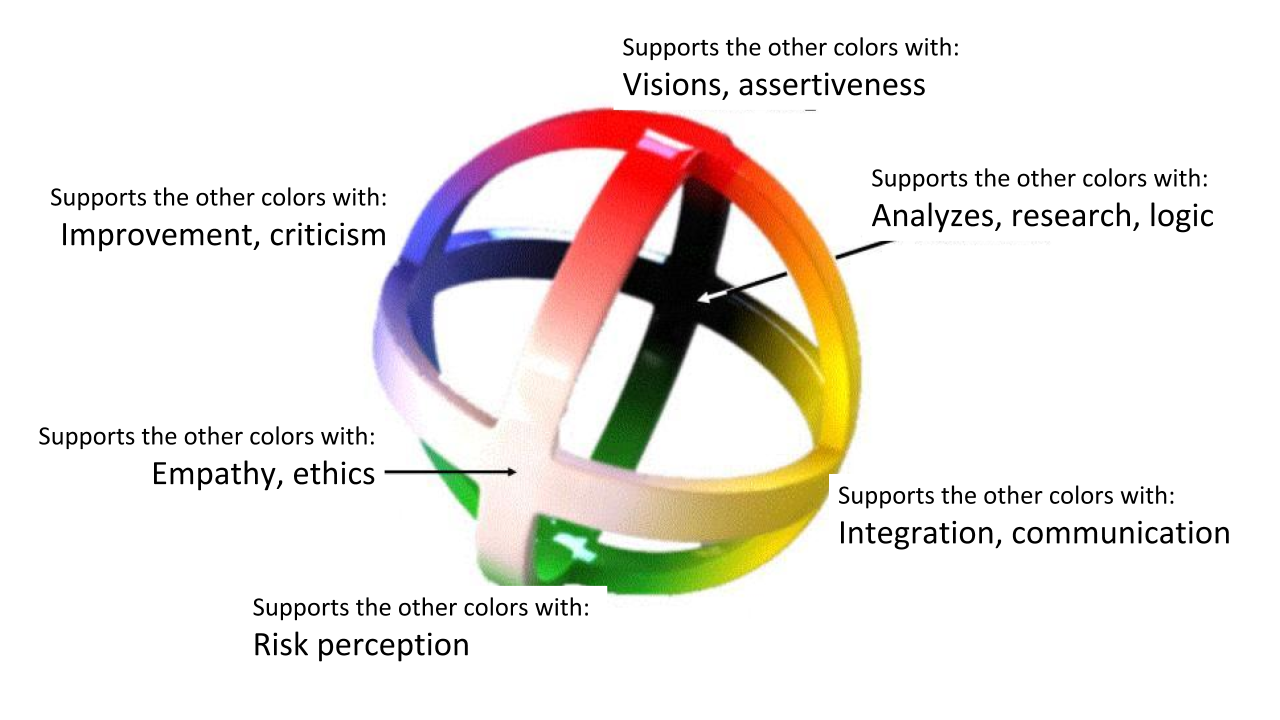Profile comparisons
"One thing is not enough for everyone. See everyone how he does it..." (Johann Wolfgang von Goethe)
The request of a software asks: What is the right thing for me? And what's the best way to do it? Of course, the response from the profile comparisons does not answer prosaically, but with interpretable data.
Let's start with the technical structure. The prerequisite for a profile comparison is that there are profiles. These are either determined in the "analysis" step or lie, such as "professional profiles" in an IPM library. Then these typical queries can be made:
- Compare = Compare the profile to ID-x (e.g. superior) with that of ID-y (e.g. employee)
- Select = Search for profile ID-x (e.g. job profile) the best 10 matching from the series ID-1 to ID-n (e.g. applicant)
The technology doesn't care about the content. It is only a question of answering the user's questions (request) with facts (response). For example, the contents can look like this:

The next step is to interpret and present the results, for example:
Interpretation: The offer fits 80% to the customer. Their needs for implementation (e.g. speed), individuality (e.g. exclusivity) and empathy (e.g. environmental friendliness) are greater. The need for integration (e.g. fashion) is lower. It makes sense to adapt the offer.
Relate values to one another
The web service responds to the request with comparative values for the 24 types of potential analysis. The values relate to different emotional or decision-making levels.

This complexity makes it possible to use the comparison functions also for other personality systems or typologies.
The matches or deviations can either be interpreted by the application software itself or, in the next step, control which results IPM should deliver.
The profile comparison focuses on two essential things: the best fit and the efficient complement.
Experience has shown that profile deviations of less than 20% are tolerable in most cases when persons or offers are matched, and that a similarity can be said. Larger deviations lead to a different way of thinking, feeling and acting depending on the depth (see picture above).
This being different has great advantages in working with other people, because different competences complement each other. Also in partnerships the "foreign" brings something fascinating with it - if there are enough similarities as a basis for the relationship.
Good fits
Profile comparisons are used for the fit.
- We want a professional task that completely fulfills us.
- We want to offer something the customer likes.
- We look for the optimal way to learn or teach.
- We reduce personality-related wastage in marketing.
- We are looking for the best possible employee.
When our inner values, goals and aspirations deviate from what the situation offers us, stress arises. We want to have a balance in ourselves and to our fellow human beings and strive for balance. If this is not possible, it can endanger our health or reduce the necessary profits in relation to our business environment.
Good supplements
For the inner balance and for the interaction with other people, however, it is also true that potential arises from opposites which, when combined, have a strong synergetic effect. When we talk about personality traits, we mean these different forces that move us in different directions. A part in us wants to go high (red) and its counterpart (green) needs to be firmly anchored in the ground. The red one alone would leave the earth, the green one would sink into the ground.

If we accept both sides, then red supports with assertiveness and green with risk assessment. This principle of mutual support also applies to the other colours. The real and successful life is colorful.
Profile comparisons also serve the purpose of optimisation.
- We stabilize developments.
- We combine rationality and emotionality.
- We want to use diverse competences.
- We learn in a holistic way.
- We avoid objections and resistances.
The examination of a profile shows which aspects are on average less pronounced for all comparison profiles, so that additions are useful.
Areas of application
The comparison functions are intended to provide information, answer questions and help to check decisions. Here are a few examples:
Which professions suit me?
How do I learn best?
Which offers offer me which benefits?
How can I integrate into the company?
How does my partner fit in with me?
How can I support my children, friends or partners?
What do I and my loved ones need to be satisfied with themselves and each
other?
Which applicant fits the job well emotionally?
Which questions should I ask in the interview?
How can superiors and employees improve their communication?
Which training measures suit which employee?
Which employee fits the team?
What competencies are missing in the team?
How can cooperation be improved?
How do I lead the team as a whole and the employee in particular?
Which customers do we address with this product?
What kind of communication suits the target group?
How do which contents affect which customer types?
How do I have a successful sales conversation with this customer?
Which arguments are positive for this customer?
What objections are to be expected?
Who can best take care of this customer?
Sometimes the answers result from the comparison of two profiles, often it is useful to relate several profiles to each other and sometimes it can be helpful to reduce the number of potential comparison profiles by a selection.
Not every software package will want to cover this itself. Therefore, prepared results can also be "ordered" via interfaces instead of data. The results can then alternatively be displayed in a separate browser window, in a frame or as an Excel table for download. More information can be found in the article "Results".